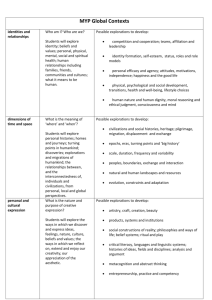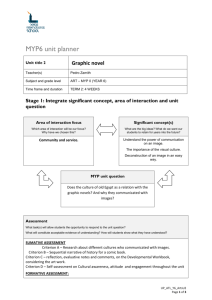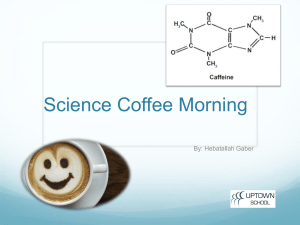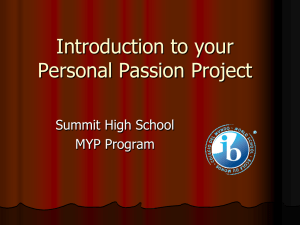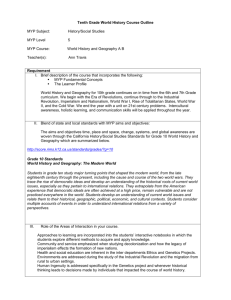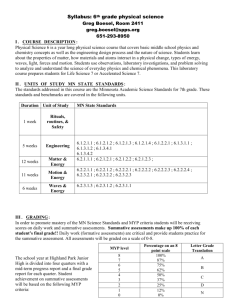userfiles/2/my files/personal project guide?id=78
advertisement
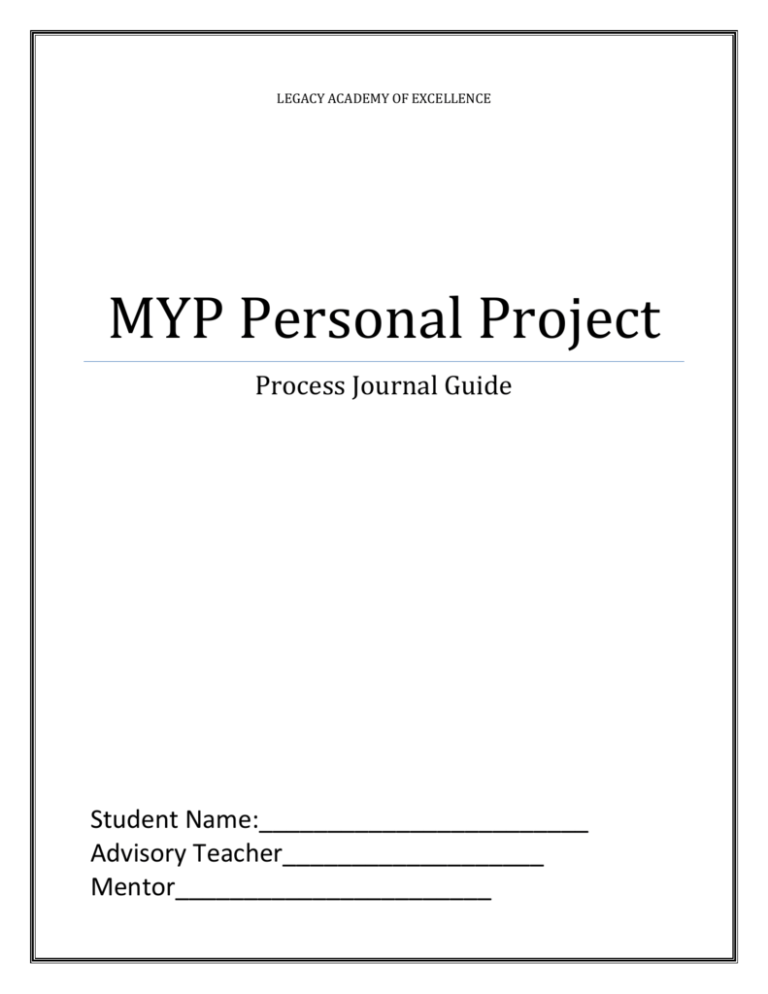
LEGACY ACADEMY OF EXCELLENCE MYP Personal Project Process Journal Guide Student Name:________________________ Advisory Teacher___________________ Mentor_______________________ Mission The mission of Legacy Academy of Excellence Charter School is to instill a lifelong passion for learning within all its students while ensuring that all learners, including those considered to be “at risk” regardless of economic and social background, succeed academically and become contributing citizens of a global society. This will be accomplished by: I. Recognizing each child’s unique abilities and talents and using these assets as the foundation for academic development and individual growth. Instructional strategies and assessments of continuous progress will be tailored to help individual students grow and develop using standards that reflect excellence and require mastery. II. Employing a well-structured, rigorous K through 12th grade curriculum that incorporates both the Core Knowledge and Direct Instruction reform models. These models will be integrated into a comprehensive program of established best practices in learning and teaching in order to develop and nurture within each child: A) The competence and passion for lifelong learning; B) Increased levels of academic performance and personal achievement required for success in the new millennium, including the ability to engage in critical and creative thinking and problem solving; C) A balanced cultural perspective consistent with a diverse community and global economy, and; D) A sense of self-worth based on achievement III. Requiring the accountability of staff, students, family, and community in the attainment of Legacy Charter School’s mission. For families, students and staff this includes commitment to the policies, procedures and rules of the Academy as evidenced by concurrence with a written accountability agreement. IV. Finally, it is the belief of the founders that systematic thinking coupled with the use of a systems model will allow the maintenance of effective connections among the various functions and operating elements. The founders subscribe to the systems model from Cordell and Waters (1993) which defines the 3 domains of school systems: ■ Technical Domain o Standards o Curriculum o Instruction o Assessments ■ Personal Domain o Professional Development o Leadership & Supervision o Internal Communication o Climate and Culture ■ Organizational Domain o External Environment o Stakeholders o Resource Allocation o Technology o Accountability Aligning the elements of each domain into a coherent, functional system will operationalize the attainment of Legacy’s mission, vision, and fundamental goals. LAE’s Assessment Policy requires teachers to provide students with assessment tasks that encourage continued learning and promote inquiry. Students are given explicit objectives and assessment criteria, as outlined in each MYP subject guide and are well informed of the expected outcomes and norms. LAE’s students are provided specific feedback that highlights their strengths and addresses areas for improvement. Student reflection and goal setting are intrinsic components of the assessment program. LAE’s Assessment program includes the nurturing of intercultural understanding and respect among students, while also providing opportunities for exploration in real-world contexts. MYP projects are student-centered and age-appropriate, and they enable students to engage in practical explorations through a cycle of inquiry, action and reflection. MYP projects help students to develop the attributes of the IB learner profile; provide students with an essential opportunity to demonstrate ATL skills developed through the MYP; and foster the development of independent, lifelong learners. Legacy Academy of Excellence’s year 1 students(6th Grade) will be the first MYP students to complete the full process of the personal project started in year 3(grade 8) and presenting their project in year 5(10th grade) of the Middle Years Program during legacy Academy of Excellence’s student exhibition. Please see Personal Project Timeline below: MYP project objectives The objectives of MYP projects encompass the factual, conceptual, procedural and metacognitive dimensions of knowledge. The table below illustrates the distinct and overlapping objectives of the community project and personal project. The community project is currently not an option, but will be phased in and offered upon authorization. Community Project Personal Project Objective A i. Define a goal to address a need within a community, based on personal interests i. Define a clear goal and global context for the project, based on personal interests ii. Identify prior learning and subject-specific knowledge relevant to the project iii. Demonstrate research skills Objective B i. Develop a proposal for action to serve the need in the community i. Develop criteria for the product/outcome ii. Plan and record the development process of the project iii. Demonstrate self-management skills Objective C i. Demonstrate service as action as a result of the project i. Create a product/outcome in response to the goal, global context and criteria ii. Demonstrate thinking skills iii. Demonstrate communication and social skills Objective D i. Evaluate the quality of the service as action against the proposal ii. Reflect on how completing the project has extended their knowledge and understanding of service learning iii. Reflect on their development of ATL skills i. Evaluate the quality of the product/outcome against their criteria ii. Reflect on how completing the project has extended their knowledge and understanding of the topic and the global context iii. Reflect on their development as IB learners through the project Assessment for the MYP community and personal project is criterion-related, based on four equally weighted assessment criteria. Criterion A: Investigating Maximum 8 Criterion B: Planning Maximum 8 Criterion C :Taking action Maximum 8 Criterion D: Reflecting Maximum 8 MYP community and personal projects assess all strands of all four assessment criteria. The annual student exhibition program displays students work and showcases their creative projects and endeavors. A key component of the Middle Years Program is the personal project which is a culminating requirement of all LAE’s Middle Years Program students. The Personal Project is a learner-centered project completed by students in MYP year 5 (grade 10). This project promotes inquiry and helps students exercise their independent learning skills. Students select topics and products of their own choosing. Encouraged to focus on their areas of interest, students have the freedom to design a project about which they are truly passionate. Whatever topic they choose, students call upon the concepts and skills they have gained during their time in the MYP to make their project successful. The Personal Project requires students to utilize the Approaches to Learning skills, which they have developed, specifically in the areas of information literacy, communication, collaboration, thinking, reflection and transfer. Each student meets regularly with a staff advisor for guidance and clarification. Students are required to maintain a process journal, as they work to complete their Personal Projects. This journal, along with the final product, report and bibliography, are the basis for the Personal Project and are assessed using the Personal Project criteria: Criterion A – Use the process journal Criterion B – Define the goal Criterion C – Select sources Criterion D – Apply information Criterion E – Achieve the goal Criterion F – Reflect on learning Criterion G – Report the project Have you ever wanted to build a musical instrument? Do you have questions about a topic that you have wanted to research on your own? Do you have a secret passion to write a play? Now is your chance! The Personal Project is your project to do what you want to do, to show the skills you have developed since sixth grade in the IB Middle Years Program. The Personal Project is an individual project completed in your 10th-grade year. It consists of three main components: a product, a process journal, and a report/reflection paper. You will choose a topic and enjoy learning about it as you research and develop your chosen product. The Personal Project can take many forms, but all must be framed by one Global Context. The following are some examples to inspire your thinking. MYP Global Contexts identities and relationships Who am I? Who are we? Students will explore identity; beliefs and values; personal, physical, mental, social and spiritual health; human relationships including families, friends, communities and cultures; what it means to be human. Possible explorations to develop: competition and cooperation; teams, affiliation and leadership identity formation, self-esteem, status, roles and role models personal efficacy and agency; attitudes, motivations, independence; happiness and the good life physical, psychological and social development, transitions, health and well-being, lifestyle choices Orientation in space and time What is the meaning of ‘where’ and ‘when’? Students will explore personal histories; homes and journeys; turning points in humankind; discoveries; explorations and migrations of humankind; the relationships between, and the interconnectedness of, individuals and civilizations, from personal, local and global perspectives. human nature and human dignity, moral reasoning and ethical judgment, consciousness and mind Possible explorations to develop: civilizations and social histories, heritage; pilgrimage, migration, displacement and exchange epochs, eras, turning points and ‘big history’ scale, duration, frequency and variability peoples, boundaries, exchange and interaction natural and human landscapes and resources personal and cultural expression What is the nature and purpose of creative expression? Students will explore the ways in which we discover and express ideas, feelings, nature, culture, beliefs and values; the ways in which we reflect on, extend and enjoy our creativity; our appreciation of the aesthetic. evolution, constraints and adaptation Possible explorations to develop: artistry, craft, creation, beauty products, systems and institutions social constructions of reality; philosophies and ways of life; belief systems; ritual and play critical literacy, languages and linguistic systems; histories of ideas, fields and disciplines; analysis and argument metacognition and abstract thinking scientific and technical innovation How do we understand the worlds in which we live? Students will explore the natural world and its laws; the interaction between people and the natural world; how humans use their understanding of scientific principles; the impact of scientific and technological advances on communities and environments; the impact of environments on human activity; how humans adapt environments to their needs. globalization and sustainability How is everything connected? Students will explore the interconnectedness of human-made systems and communities; the relationship between local and global processes; how local experiences mediate the global; reflect on the opportunities and tensions provided by worldinterconnectedness; the impact of decision- entrepreneurship, practice and competency Possible explorations to develop: systems, models, methods; products, processes and solutions adaptation, ingenuity and progress opportunity, risk, consequences and responsibility modernization, industrialization and engineering digital life, virtual environments and the information age the biological revolution mathematical puzzles, principles and discoveries Possible explorations to develop: markets, commodities and commercialization human impact on the environment commonality, diversity and interconnection consumption, conservation, natural resources and public goods population and demography urban planning, strategy and infrastructure fairness and development making on humankind and the environment. What are the consequences of our common humanity? Students will explore rights and responsibilities; the relationship between communities; sharing finite resources with other people and with other living things; access to equal opportunities; peace and conflict resolution. Possible explorations to develop: democracy, politics, government and civil society inequality, difference and inclusion human capability and development ; social entrepreneurs rights, law, civic responsibility and the public sphere justice, peace and conflict management power and privilege authority , security and freedom imagining a hopeful future A complete Personal Project has three elements: the project itself, the written statement, and the Process Journal. Each is important and each is required. The Product The main element of the Personal Project is the product you intend to create. As stated earlier, it may take a variety of physical forms based on the Global Context you choose. If it is not something that may be submitted, such as a performance or community service project, you should take pictures throughout the process to document your work. Process Journal Through each phase of the Personal Project, you will be responsible for maintaining a process journal to document the choices you made and an evaluation of why you made them. You will receive a set of journal prompts that directly relate to the sections of the reflection paper you will write after the creation of your product. You will submit your process journals as part of your project. You will be able to use some of the Learning Seminar time for writing in your journal. The Report All Personal Projects include a structured piece of writing that begins by defining the goals of your project, establishing the area of interaction on which you focused, and an outlining how you intend to achieve the goal. Next, you will describe the process of your work, analyze the inspiration and research that guided your work, and identify the findings you made through creating the product. Finally, you will conclude by reflecting on the impact of your project and the new perspectives it provided you. identities and relationships Who am I? Who are we? Students will explore identity; beliefs and values; personal, physical, mental, social and spiritual health; human relationships including families, friends, communities and cultures; what it means to be human. Orientation in space and time personal and cultural expression scientific and technical innovation What is the meaning of ‘where’ and ‘when’? Students will explore personal histories; homes and journeys; turning points in humankind; discoveries; explorations and migrations of humankind; the relationships between, and the interconnectedness of, individuals and civilizations, from personal, local and global perspectives. What is the nature and purpose of creative expression? Students will explore the ways in which we discover and express ideas, feelings, nature, culture, beliefs and values; the ways in which we reflect on, extend and enjoy our creativity; our appreciation of the aesthetic. How do we understand the worlds in which we live? Students will explore the natural world and its laws; the interaction between people and the natural world; how humans use their understanding of scientific principles; the impact of scientific and technological advances on communities and environments; the impact of environments on human activity; how humans adapt environments to their needs. globalization and sustainability fairness and development How is everything connected? Students will explore the interconnectedness of human-made systems and communities; the relationship between local and global processes; how local experiences mediate the global; reflect on the opportunities and tensions provided by worldinterconnectedness; the impact of decision-making on humankind and the environment. What are the consequences of our common humanity? Students will explore rights and responsibilities; the relationship between communities; sharing finite resources with other people and with other living things; access to equal opportunities; peace and conflict resolution. identities and relationships Who am I? Who are we? Students will explore identity; beliefs and values; personal, physical, mental, social and spiritual health; human relationships including families, friends, communities and cultures; what it means to be human. Orientation in space and time personal and cultural expression scientific and technical innovation What is the meaning of ‘where’ and ‘when’? Students will explore personal histories; homes and journeys; turning points in humankind; discoveries; explorations and migrations of humankind; the relationships between, and the interconnectedness of, individuals and civilizations, from personal, local and global perspectives. What is the nature and purpose of creative expression? Students will explore the ways in which we discover and express ideas, feelings, nature, culture, beliefs and values; the ways in which we reflect on, extend and enjoy our creativity; our appreciation of the aesthetic. How do we understand the worlds in which we live? Students will explore the natural world and its laws; the interaction between people and the natural world; how humans use their understanding of scientific principles; the impact of scientific and technological advances on communities and environments; the impact of environments on human activity; how humans adapt environments to their needs. globalization and sustainability How is everything connected? fairness and development Students will explore the interconnectedness of human-made systems and communities; the relationship between local and global processes; how local experiences mediate the global; reflect on the opportunities and tensions provided by worldinterconnectedness; the impact of decision-making on humankind and the environment. What are the consequences of our common humanity? Students will explore rights and responsibilities; the relationship between communities; sharing finite resources with other people and with other living things; access to equal opportunities; peace and conflict resolution.
